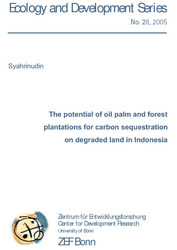| Departments | |
|---|---|
| Book Series (96) |
1378
|
| Nachhaltigkeit |
3
|
| Gesundheitswesen |
1
|
| Humanities |
2365
|
| Natural Sciences |
5406
|
| Mathematics | 229 |
| Informatics | 319 |
| Physics | 980 |
| Chemistry | 1363 |
| Geosciences | 131 |
| Human medicine | 243 |
| Stomatology | 10 |
| Veterinary medicine | 108 |
| Pharmacy | 147 |
| Biology | 835 |
| Biochemistry, molecular biology, gene technology | 121 |
| Biophysics | 25 |
| Domestic and nutritional science | 45 |
| Agricultural science | 1004 |
| Forest science | 201 |
| Horticultural science | 20 |
| Environmental research, ecology and landscape conservation | 148 |
| Engineering |
1793
|
| Common |
98
|
|
Leitlinien Unfallchirurgie
5. Auflage bestellen |
|
Advanced Search
The potential of oil palm and forest plantations for carbon sequestration on degraded land in Indonesia (Volume 28) (English shop)
- Syahrinudin (Author)Preview
Table of Contents, Datei (29 KB)
Extract, Datei (70 KB)
Plant biomass represents a sink for atmospheric carbon dioxide, which is one of the most important greenhouse gases and which is assumed to contribute more than half of the global warming. Establishing tree plantations or perennial crops on degraded land is an effective way to reduce atmospheric carbon by building up terrestrial carbon stocks, not only in the living biomass, but also in the soil. By converting Imperata cylindrica grassland into tree plantations (Acacia mangium or oil palm), aboveground biomass carbon can be increased about 20-fold and belowground biomass carbon up to 8-fold, while soil carbon can almost be doubled.
| ISBN-13 (Printausgabe) | 3865374816 |
| ISBN-13 (Hard Copy) | 9783865374813 |
| ISBN-13 (eBook) | 9783736914810 |
| Language | German |
| Page Number | 120 |
| Edition | 1 Aufl. |
| Book Series | ZEF Bonn |
| Volume | 28 |
| Publication Place | Göttingen |
| Place of Dissertation | Bonn |
| Publication Date | 2005-07-05 |
| General Categorization | Dissertation |
| Departments |
Agricultural science
|








